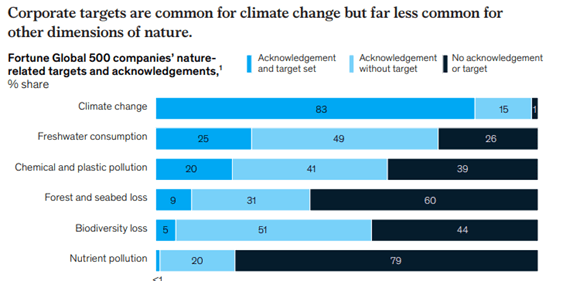Understanding Double Materiality in the ESRS Framework
A foundational step in the European Sustainability Reporting Standards (ESRS) framework is conducting a double materiality analysis. This approach, mandated by the Corporate Sustainability Reporting Directive (CSRD), requires companies to assess not only how environmental, social, and governance (ESG) issues affect their financial performance (financial materiality) but also how their operations impact the environment and society (impact materiality).
Very often, biodiversity is a blind spot
Why is dealing with this blind spot important?
Biodiversity refers to the variety of life on Earth, including the variety of species, ecosystems, and genetic diversity within species. Despite its importance, biodiversity often remains a blind spot for companies for several reasons:
- Lack of Awareness: many companies are not fully aware of how their operations impact and depend on biodiversity or how biodiversity loss can affect their business.
- Complexity and Measurement Challenges: biodiversity is complex and multi-faceted, making it difficult to measure and report on. Unlike carbon emissions, which have relatively straightforward metrics, biodiversity encompasses various elements such as species richness, ecosystem health, and genetic diversity, which are harder to quantify.
- Indirect Impacts: the impacts on biodiversity are often indirect and may occur over long time periods, making them less apparent and harder to link directly to business activities.
Regulatory and Reporting Gaps: until recently, there has been less regulatory pressure and fewer guidelines for companies to report on biodiversity impacts compared to other ESG factors such as greenhouse gas emissions.
How can companies address Biodiversity in Double Materiality Analysis?
- Identify Biodiversity Impacts: understand and map out the direct and indirect impacts of business activities on biodiversity. This includes assessing supply chain impacts and dependencies on natural ecosystems.
- Engage Stakeholders: work with stakeholders, including local communities, conservation groups, and policymakers, to understand biodiversity concerns and expectations.
- Set Clear Goals and Targets: establish specific, measurable goals for biodiversity conservation and restoration. This may involve adopting best practices such as the Taskforce on Nature-related Financial Disclosures (TNFD) guidelines or the Science-Based Targets for Nature.
- Monitor and Report: implement robust monitoring systems to track biodiversity impacts and progress toward goals. Report transparently on findings and actions taken to mitigate negative impacts.
- Integrate Biodiversity into Business Strategy: embed biodiversity considerations into the company’s overall strategy, including risk management, product development, and corporate social responsibility initiatives.
Studies show that many companies have an impact on biodiversity, but do not acknowledge this and have no targets set

(Source McKinsey)
To effectively define potential financial impacts, dependencies, and material risks, a consistent and thorough analysis is required. This task is particularly challenging, as it involves understanding complex interactions and assessing various factors. Many companies find it difficult to conduct an initial analysis due to the intricate nature of the work and a lack of expertise in identifying and evaluating these risks.
Biodiversity affects everybody

(Source S&P)
Ending with a quote of Edward O. Wilson, a renowned biologist and naturalist:
« Biodiversity is the greatest treasure we have… Its diminishment is to be prevented at all costs».
Biodiversity is the foundation of life on Earth, supporting ecosystems, human health, and economic development. Its protection is crucial for sustaining the natural balance and ensuring a resilient and vibrant planet for future generations. Understanding and valuing biodiversity is the first step towards conserving the rich variety of life that makes our world unique and sustaining.
May this be an inspiration to start your biodiversity journey.







